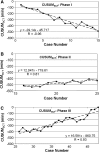Learning curve for robotic-assisted laparoscopic colorectal surgery
- PMID: 20734081
- PMCID: PMC3044842
- DOI: 10.1007/s00464-010-1281-x
Learning curve for robotic-assisted laparoscopic colorectal surgery
Abstract
Background: Robotic-assisted laparoscopic surgery (RALS) is evolving as an important surgical approach in the field of colorectal surgery. We aimed to evaluate the learning curve for RALS procedures involving resections of the rectum and rectosigmoid.
Methods: A series of 50 consecutive RALS procedures were performed between August 2008 and September 2009. Data were entered into a retrospective database and later abstracted for analysis. The surgical procedures included abdominoperineal resection (APR), anterior rectosigmoidectomy (AR), low anterior resection (LAR), and rectopexy (RP). Demographic data and intraoperative parameters including docking time (DT), surgeon console time (SCT), and total operative time (OT) were analyzed. The learning curve was evaluated using the cumulative sum (CUSUM) method.
Results: The procedures performed for 50 patients (54% male) included 25 AR (50%), 15 LAR (30%), 6 APR (12%), and 4 RP (8%). The mean age of the patients was 54.4 years, the mean BMI was 27.8 kg/m(2), and the median American Society of Anesthesiologists (ASA) classification was 2. The series had a mean DT of 14 min, a mean SCT of 115.1 min, and a mean OT of 246.1 min. The DT and SCT accounted for 6.3% and 46.8% of the OT, respectively. The SCT learning curve was analyzed. The CUSUM(SCT) learning curve was best modeled as a parabola, with equation CUSUM(SCT) in minutes equal to 0.73 × case number(2) - 31.54 × case number - 107.72 (R = 0.93). The learning curve consisted of three unique phases: phase 1 (the initial 15 cases), phase 2 (the middle 10 cases), and phase 3 (the subsequent cases). Phase 1 represented the initial learning curve, which spanned 15 cases. The phase 2 plateau represented increased competence with the robotic technology. Phase 3 was achieved after 25 cases and represented the mastery phase in which more challenging cases were managed.
Conclusions: The three phases identified with CUSUM analysis of surgeon console time represented characteristic stages of the learning curve for robotic colorectal procedures. The data suggest that the learning phase was achieved after 15 to 25 cases.
Figures



Similar articles
-
Cumulative summation analysis of learning curve for robotic-assisted hiatal hernia repairs.Surg Endosc. 2022 May;36(5):3442-3450. doi: 10.1007/s00464-021-08665-x. Epub 2021 Jul 29. Surg Endosc. 2022. PMID: 34327550
-
Learning curve for robotic-assisted laparoscopic rectal cancer surgery.Int J Colorectal Dis. 2013 Jun;28(6):815-21. doi: 10.1007/s00384-012-1620-6. Epub 2012 Dec 15. Int J Colorectal Dis. 2013. PMID: 23242270
-
Prior experience in laparoscopic rectal surgery can minimise the learning curve for robotic rectal resections: a cumulative sum analysis.Surg Endosc. 2017 Oct;31(10):4067-4076. doi: 10.1007/s00464-017-5453-9. Epub 2017 Mar 7. Surg Endosc. 2017. PMID: 28271267
-
Robotic-assisted laparoscopic surgery for recurrent diverticulitis: experience in consecutive cases and a review of the literature.Surg Endosc. 2011 Jan;25(1):199-206. doi: 10.1007/s00464-010-1159-y. Epub 2010 Jun 22. Surg Endosc. 2011. PMID: 20567850 Review.
-
Appraisal and Current Considerations of Robotics in Colon and Rectal Surgery.J Laparoendosc Adv Surg Tech A. 2019 Feb;29(2):152-158. doi: 10.1089/lap.2018.0571. Epub 2018 Oct 16. J Laparoendosc Adv Surg Tech A. 2019. PMID: 30325690 Review.
Cited by
-
Characterizing the learning curve of the VBLaST-PT(©) (Virtual Basic Laparoscopic Skill Trainer).Surg Endosc. 2013 Oct;27(10):3603-15. doi: 10.1007/s00464-013-2932-5. Epub 2013 Apr 10. Surg Endosc. 2013. PMID: 23572217 Free PMC article.
-
Learning curve for single-port robot-assisted rectal cancer surgery.Ann Surg Treat Res. 2022 Mar;102(3):159-166. doi: 10.4174/astr.2022.102.3.159. Epub 2022 Mar 4. Ann Surg Treat Res. 2022. PMID: 35317355 Free PMC article.
-
Robot-assisted right colectomy: surgical technique and review of the literature.Wideochir Inne Tech Maloinwazyjne. 2013 Sep;8(3):253-7. doi: 10.5114/wiitm.2011.33761. Epub 2013 Mar 6. Wideochir Inne Tech Maloinwazyjne. 2013. PMID: 24130643 Free PMC article.
-
The 100 most influential manuscripts in robotic surgery: a bibliometric analysis.J Robot Surg. 2020 Feb;14(1):155-165. doi: 10.1007/s11701-019-00956-9. Epub 2019 Apr 4. J Robot Surg. 2020. PMID: 30949890
-
Use of robotics in colon and rectal surgery.Clin Colon Rectal Surg. 2013 Mar;26(1):39-46. doi: 10.1055/s-0033-1333660. Clin Colon Rectal Surg. 2013. PMID: 24436647 Free PMC article. Review.
References
-
- Taylor RH, Funda J, Eldridge B, Gomory S, Gruben K, LaRose D, Talamini M, Kavoussi L, Anderson J. A telerobotic assistant for laparoscopic surgery. IEEE Eng Med Biol. 1995;14:279–288. doi: 10.1109/51.391776. - DOI
-
- Chaput de Saintonge DM, Vere DW (1974) Why don’t doctors use CUSUMs? Lancet 1:120–121 - PubMed
MeSH terms
LinkOut - more resources
Full Text Sources
Medical
Research Materials
Miscellaneous

